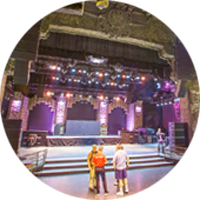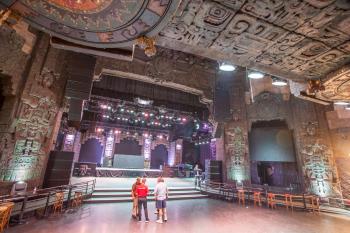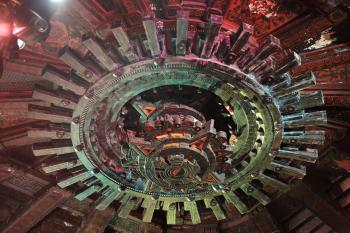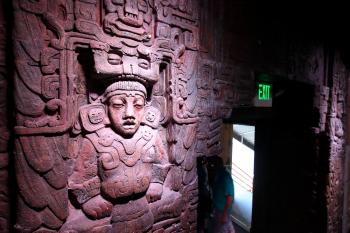

<< Go Back up to Region ‘Los Angeles: Downtown’
| Follow Mike Hume’s Historic Theatre Photography: |  |
 |

Architects: Morgan, Walls & Clements
First Opened: 15th August 1927 (98 years ago)
Reopened as a nightclub: 9th March 1990
Former Names: Fabulous Mayan, Club Mayan
Status: Reopening early 2026
Website: themayanla.com 
Telephone: (213) 746-4674 
Address: 1038 South Hill Street, Los Angeles, CA 90015 
The Mayan Theatre in downtown Los Angeles is a stunning example of the 1920s fascination with revival-style theatre architecture, in this case Mayan Revival. The Mayan opened its doors in 1927 as a legitimate theatre; it is now used as a music/nightclub and live events venue. Between times it has showcased movies, blue movies, and has been the scene of many movie location shoots.

 Detailed Information
Detailed Information
Fascination with Mexican art and culture in the United States during the 1920s and 1930s was a big reason for the popularity of the Mayan Revival style of architecture at the time. Many hotels and theatres were built in the Mayan or Aztec Revival styles, such as the extant Aztec Hotel in Monrovia, California. The Mayan is one of only four remaining theatres to have been designed in the style, the others being the Aztec Theatre in San Antonio, Texas, the Lincoln Theatre in Marion, Virginia, and the Mayan Theatre in Denver, Colorado. The 3,500-seat Fisher Theater in Detroit (opened 1928) was originally a very fine example of the style, however was renovated into a smaller 2,100-seat playhouse at the start of the 1960s and given a new mid-century décor.
Designed by the architectural firm of Morgan, Walls & Clements, with Stiles O. Clements taking the lead, the theatre originally seated 1,491 on two levels and was intended as a musical comedy house. Despite being located immediately next to the Belasco Theatre, which had opened 10 months earlier in November 1926, both theatres were under the same management and so programming was designed to be complementary, not competitive.
Legitimate drama ran at the Belasco with the Mayan staging musical comedies. It is noted in contemporary newspaper reports of the time that the Belasco took the overflow audience from the Mayan on at least one occasion, proving the management arrangement of the two theatres was a success.
In November 1926 when the Belasco Theatre opened, the Los Angeles Times reported that the new theatre next door would open “during the next six months ... [and be] known as the Stowell [Theatre]”. However at an early stage of the Mayan’s planning, one of the theatre’s management team, Gerhold O. Davis, read a newspaper article about the extensive accomplishments of the Mayan civilization and subsequently hired the author, a young Mexican artist named Francisco Cornejo, to design the interior of the new theatre with a Mayan theme.

The theatre features 12ft (3.7m) wide sidestages (alternatively “tableau” or “connecting stages”) on either side of the proscenium arch, located where auditorium boxes or organ grilles would normally be placed. Prior to the theatre’s opening, the Los Angeles Times described them as a “distinct novelty” and declared it the first time such an arrangement had been seen throughout all of America.
The sidestages were intended to be used between scenes, for interludes between acts, or for special musical numbers. They were fitted with their own miniature fire curtains and act drops, complementing the design on the main fire curtain featuring Mayan jungles and temples. On a technical point it’s interesting to note that the grid structure above the stage extends over the sidestages, forward of the proscenium arch.

The main feature of the auditorium is the massive centerpiece lighting fixture, a sun design inspired by Mayan solar worship with roof beams behind depicting the Mayan calendar. The auditorium’s sidewalls feature depictions of the feathered serpent Quetzalcoatl, set above massive carved stone blocks (created in plaster) in the Cyclopean style. Although Mayan architecture was the focus, some features from Aztec architecture were included for contrast such as the Aztec eagle warrior figure which features on several exit doors.
The main lobby boasts intricate detail from both Mayan and Aztec cultures and was modeled after The Hall of the Feathered Serpents. For a long time the original exterior ticket lobby had a drop ceiling however this has now been removed to reveal a deeply-coffered ceiling in three parts which would have probably featured a small patch of painted sky in the three centers, reminiscent of openings to the sky at the top of Mayan temples.

Backstage, the majority of dressing rooms were organized around a central Green Room located directly underneath the stage (the Green Room would also function as the Trap Room should trapdoors in the stage be required). A Star dressing room was located at stage level (Stage Left) with some additional rooms above it.
Starting with its opening production of “Oh, Kay!” in August 1927, backstage staff and actors recorded the shows running at the theatre on a wall in the basement Pump Room. This list survives today, preserved by the current tenants, and provides valuable insight into the programming of the theatre over its long history. The theatre is also notable for originally having had a paint bridge at the rear of the stage. Only supporting beams for the paint bridge are visible now.
In 1947 Frank Fouce acquired the building and over the coming years changed the theatre’s policy to largely Spanish language films with occasional stage shows, comics, and singers. The 8th May 1948 edition of Boxoffice reported that the Mayan would be abandoning its “film-stage show combine policy” in favor of all-film bookings as of 31st May 1948.

In 1968 the theatre was sub-leased to Carlos Tobalina and renamed the Fabulous Mayan, exhibiting porn movies. The façade’s current colorful decoration dates from this time, replacing the original “dull two-tone scheme of tan and orange”. In 1969 the theatre was triplexed, then later that year the Fouce family sold the theatre to Tobalina.
On 11th June 1989 the Mayan screened its last porno “Passion” before closing its doors. Restaurant and nightclub owner Sammy Chao and entrepreneur Daniel Sullivan had been in discussion with the Tobalinas for about a year on re-imagining the Mayan as a nightclub. Initially it was planned to be called Lost City and open in late 1989, however the name changed to Club Mayan by the time it opened in March 1990.
Chao worked with the Los Angeles Historic Theatre Foundation  as an advisor to re-open the theatre as a vibrant entertainment and live events venue while respecting the theatre’s heritage going back to 1927. On the main floor the seating area was leveled from the stage to the balcony overhang (in a reversible manner should the theatre ever return to legitimate use), then terraced under the balcony. The gala opening, held in aid of the Los Angeles Conservancy
as an advisor to re-open the theatre as a vibrant entertainment and live events venue while respecting the theatre’s heritage going back to 1927. On the main floor the seating area was leveled from the stage to the balcony overhang (in a reversible manner should the theatre ever return to legitimate use), then terraced under the balcony. The gala opening, held in aid of the Los Angeles Conservancy  , took place on Friday 9th March 1990.
, took place on Friday 9th March 1990.
As of 2022 the Tobalina family still own the theatre, and the Mayan is still operating – with Sammy Chao and his daughter Susan at the helm – as a hugely popular independent live entertainment and music venue in downtown Los Angeles.
On 14th July 2025 it was announced  on the Mayan’s social media channels that the Mayan would be closing, in its current incarnation, by the end of September 2025. The Mayan team invited everyone to join them every Saturday night through 13th September for one last celebration. For clarification, it is the leaseholder who is relinquishing their lease after an amazing 35 years operating the theatre as a nightclub and live events venue. The leaseholder is not the same as the owner of the theatre.
on the Mayan’s social media channels that the Mayan would be closing, in its current incarnation, by the end of September 2025. The Mayan team invited everyone to join them every Saturday night through 13th September for one last celebration. For clarification, it is the leaseholder who is relinquishing their lease after an amazing 35 years operating the theatre as a nightclub and live events venue. The leaseholder is not the same as the owner of the theatre.
The Mayan has featured in many movies including The Bodyguard (1992)  , Save The Tiger (1973)
, Save The Tiger (1973)  , A Night at the Roxbury (1998)
, A Night at the Roxbury (1998)  , The Replacement Killers (1998)
, The Replacement Killers (1998)  , and Playing by Heart (1998)
, and Playing by Heart (1998)  .
.
Be sure to check out our research into this and other projects by Morgan, Walls & Clements in the archive of their work held at the Huntington Library  in California.
in California.
 Movie, TV & Music Video Appearances
Movie, TV & Music Video Appearances . Interior of The Roxbury.
. Interior of The Roxbury.


 . Nightclub scenes.
. Nightclub scenes.
 . Exterior (concert scenes).
. Exterior (concert scenes).

 . The Mayan features extensively in the opening nightclub scene.
. The Mayan features extensively in the opening nightclub scene. . Features as a nightclub.
. Features as a nightclub.
 . Episode: Countdown (2003). The Mayan doubles as the location for a lucha libre / Mexican wrestling venue in Guadalajara, Mexico.
. Episode: Countdown (2003). The Mayan doubles as the location for a lucha libre / Mexican wrestling venue in Guadalajara, Mexico.
 . Episode: Panic! At The Disco (2016).
. Episode: Panic! At The Disco (2016). . Episode: The Next Big Thing.
. Episode: The Next Big Thing. Video from our YouTube channel:
Video from our YouTube channel: Listed/Landmark Building Status
Listed/Landmark Building Status How do I visit the Mayan Theatre?
How do I visit the Mayan Theatre?As of March 2017 The Mayan does not offer tours and neither do independent companies. Your best bet is to attend one of the many and varied events The Mayan hosts. Click here for their events calendar  .
.
 Further Reading
Further Reading contains a huge amount of additional information including original plans, playbills, photographs and movie appearances of The Mayan.
contains a huge amount of additional information including original plans, playbills, photographs and movie appearances of The Mayan. contains further history and a great selection of photos.
contains further history and a great selection of photos. has further information and some great photos of The Mayan.
has further information and some great photos of The Mayan. contains further information, calendar of events and online booking for events at The Mayan.
contains further information, calendar of events and online booking for events at The Mayan. (originally published as two volumes in 1927 and 1930; reissued as a single volume in 2009 by the Theatre Historical Society of America), by R.W. Sexton and B.F. Betts, published by Liber Apertus Press. ISBN 0978588169.
(originally published as two volumes in 1927 and 1930; reissued as a single volume in 2009 by the Theatre Historical Society of America), by R.W. Sexton and B.F. Betts, published by Liber Apertus Press. ISBN 0978588169. , by Suzanne Tarbell Cooper, Amy Ronnebeck Hall, and Marc Wanamaker, published by Arcadia Publishing. ISBN 9780738555799.
, by Suzanne Tarbell Cooper, Amy Ronnebeck Hall, and Marc Wanamaker, published by Arcadia Publishing. ISBN 9780738555799. by David Naylor, published by Preservation Press. ISBN 0891331271.
by David Naylor, published by Preservation Press. ISBN 0891331271. Technical Information
Technical Information Photos of the Mayan Theatre
Photos of the Mayan TheatrePhotographs copyright © 2002-2025 Mike Hume / Historic Theatre Photos unless otherwise noted.
Text copyright © 2017-2025 Mike Hume / Historic Theatre Photos.
For photograph licensing and/or re-use contact us here  . See our Sharing Guidelines here
. See our Sharing Guidelines here  .
.
| Follow Mike Hume’s Historic Theatre Photography: |  |
 |